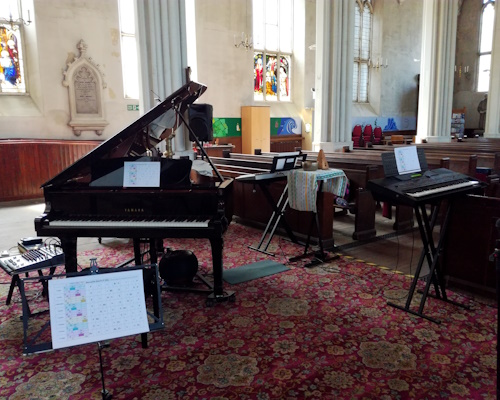Cathedral at Noon
Intuitive Music Aberdeen
Saturday 3 June 2023 • 12 noon
St Andrew's Cathedral • 28 King Street • ABERDEEN • AB24 5AX

Review by Alan Cooper
Programme
Haworth Hodgkinson
Bennachie Sketch (2019)
First Aberdeen performance
Haworth Hodgkinson
An Odd Pavan (2023)
World premiere performance
The first of two pieces performed by Intuitive Music Aberdeen, entitled Bennachie Sketch, was first performed at Leith Hall in 2019. It was to have been performed in St Andrew's Cathedral in 2020 but Covid got in the way so instead it was receiving its first Aberdeen performance today, Saturday 3rd June 2023. As the brief programme note stated, it invites the audience to imagine spending 24 hours in the Forest of Bennachie, from 6am to 6am, that is to say in a period of 24 hours. For today's performance, that time had been compressed to around 24 minutes. Actually, thinking of the American minimalist composer La Monte Young, a 24 hour long performance would be comparatively short. Of course Intuitive Music Aberdeen has to consider time available at the venues in which they perform.
Bennachie Sketch opened with a single long-dying note on a metal bowl struck by Haworth Hodgkinson. This allowed Haworth to go to the piano and start playing a short upward rising decorative motif which though often varied, remained solidly at the very heart of the piece. Mandy Macdonald and Colin Edwards played long held notes on two different keyboards, then they took up Haworth's motif on the keyboards. I had not noticed this at first, but I gradually picked up a similarity between two separate features of bagpipe music. The upward motif reminded me of the finger decorations in bagpipe music, especially in piobaireachd, and were the held notes on the keyboards not reminiscent of bagpipe drones?
Overall, the piece was broadly forward-moving but restful too and always beautifully clean and clear. I wondered how I would have reacted to a CD version of the music, I thought dream-like could have been one answer to that. There are pieces however where being present at a live performance is crucial to the whole effect of the music. Throughout the work, each performer moved to the piano for a short stint or to one or other of the two keyboards. This was surely an integral part of the performance. Each of the performers would go and sit on a chair for a short time waiting for their turn to go to keyboard or piano. The keyboardists even had little weights to hold down a key so that the keyboard sounds would remain uninterrupted when they had to move. This worked perfectly. After the performance I was shown one of the weights. It had been made out of a beach pebble.
The piano music varied in complexity and intensity with the different performers. It was amazing how the resultant harmonies and counterpoints between the three instruments worked so well. It struck me that the three sources of the music were like pieces of a mosaic, in different colours yet related to one another and finally coming together to build up a completed picture. Sound was of primary importance in the performance but the carefully choreographed movements of the performers were vital as well, ensuring that the attention of the audience would remain riveted on the performers throughout the piece. It certainly worked for me. I loved the piece.
The second work An Odd Pavan was very much shorter. It, as the programme note stated, was Intuitive Music Aberdeen's oblique nod to the influence of these three figures. Who were these three? They were György Ligeti, Ivor Cutler and William Byrd. What an extraordinary grouping! Well they come together because the year 2023 marks the 100th anniversary of the births of György Ligeti and Ivor Cutler and the 400th anniversary of the death of William Byrd. I remember when Ivor Cutler came to Aberdeen Arts Centre as part of the Alternative Festival. He was quite extraordinary.
For this short new piece, Mandy Macdonald played piano, Haworth Hodgkinson played melodica and Colin Edwards was carefully counting out beats on a cymbal. Haworth told us that this piece required a conductor, which in this case was simply a metronome. The principal motif in this piece was a falling one. Once again everything went perfectly like clockwork we might say. I was amazed that when sounding together with the other players, the metronome seemed to be beating out three-four time. Of course it could not have been but Haworth is a clever composer and in these two works he was able to use simple material to create amazing complexities. Well done!
Links
St Andrew's Cathedral Aberdeen
Haworth Hodgkinson



